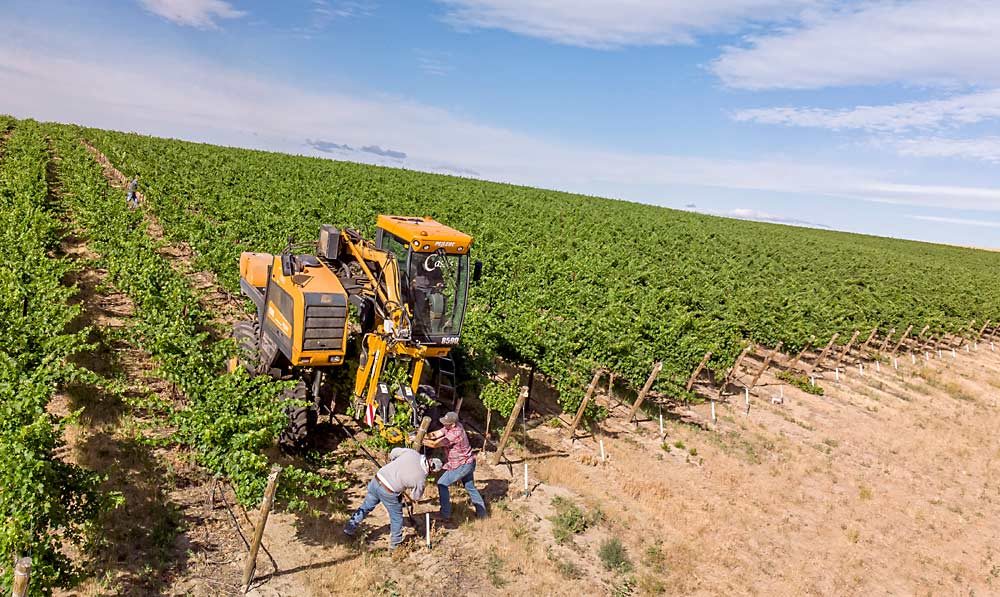
Research is a bright spot in the Washington wine industry. The Washington State Wine Commission commits roughly 25 percent of its budget to viticulture and enology research. The program is driven and guided by the industry, solely focused on needs specific to Washington, with results available to all.

Here are eight reasons to be excited about the future of viticulture and enology research in Washington:
1) In-state developments
The Washington State Grape and Wine Research Program has solid financial support. The program, funded by the Auction of Washington Wines, Washington State Wine Commission, Washington State University and the state liter tax on all wines sold, provided more than $1 million in grant awards the past three years.
Two new competitive grant programs for 2020 were recently launched by the Washington State Wine Commission to fund short-term, demonstration-type projects and extend the industry’s research reach beyond state borders.
Washington State University is working to create a new viticulture and enology degree and department by the fall of 2021, with the requirement that the final two years of study be completed at the Tri-Cities campus. This will further propel V&E research by WSU when new faculty are added.
2) Regional collaboration
There’s potential for additional federal support to increase research collaboration for small fruits (grapes and berries) through the Northwest Center for Small Fruits Research. The center, based at the U.S. Department of Agriculture’s Horticultural Crops Research Unit in Corvallis, Oregon, brings together USDA and university scientists to tackle issues specific to the Northwest.
The vacant USDA viticulture scientist position at Prosser is in line for hiring. Once filled, the position will add bandwidth to viticulture research in Washington.
A smoke exposure research planning grant, funded by USDA’s Specialty Crop Research Initiative, supports development of a collaborative research plan for Washington, Oregon and California to leverage for additional federal funds.
3) National voice
All grape segments, from table and raisin to juice and wine, have strong representation in Washington, D.C. through the National Grape Research Alliance, of which the wine commission serves on the board of directors. The alliance has elevated the importance of grape research within USDA and has been successful garnering grants from the Specialty Crop Research Initiative program.
4) Attention on specialty crops
The agricultural technology revolution that started in commodity crops such as corn now includes specialty crops. I attended a sensor technology workshop last fall, sponsored by the National Grape Research Alliance, that showcased a dizzying array of “things” that may someday help grape growers reduce labor costs and crop inputs and improve fruit quality. See the next two points for a sample of technologies discussed at the workshop.
5) Irrigation breakthroughs
A host of remote-sensing, microsensing and irrigation management tools are being developed (some already commercialized) to tell growers when and how much water their vines need. Examples include:
—Mapping daily evapotranspiration.
—Microsensors embedded in the vine to record water use.
—Water balance modeling to estimate plant available water.
—Field-scale evapotranspiration data, which NASA is working to make available free on the internet; grapes are one of their test crops.
—Detection of vine stress from open source satellite images.
—Smart drip emitters that can apply different irrigation rates to vines.
6) Zapping pests, virus-sniffing dogs
Trapping and zapping could help reduce pesticide use in the future. Potential tools include:
—Smart traps that count and identify the type of insect through photos or wing beat frequency.
—Photonic fencing that protects your vineyard by zapping insects that go through the barrier.
—Using the pheromone plume of an insect, such as grape mealybug, to target spraying.
—Potential for dogs to detect grapevine viruses, such as leafroll or red blotch, well before the vine shows signs or symptoms. Dogs have been trained to detect citrus greening disease.
7) Real-time nutrient status of your vines
Adaption of existing sensors may be able to provide a plant’s nutrient status in real-time, without collecting destructive samples. This could eventually lead to variable rate, precision application of nutrients.
8) Crop estimation, the ultimate breakthrough
Tools to estimate the grape crop are near, with several imaging system prototypes in development. WSU has its own project, funded by industry, that uses a smartphone app to estimate the grape crop.
The ultimate research goal of Washington’s wine industry is to improve the quality of grapes and wine while keeping the industry competitive — a goal harder to do with rising labor costs, droughts and tight water supplies and ever-changing environmental regulations. While it takes all types of research to help growers produce better grapes, the ag tech revolution, with its focus on mechanization and innovation, offers the best chance to help growers reduce labor and input costs to stay competitive.
Yes, it’s an exciting time for viticulture and enology research in Washington. •
—by Melissa Hansen
Melissa Hansen is the research program director for the Washington State Wine Commission. To learn more about the Washington State Wine Commission’s research program, visit: washingtonwine.org/research/reports.






Leave A Comment